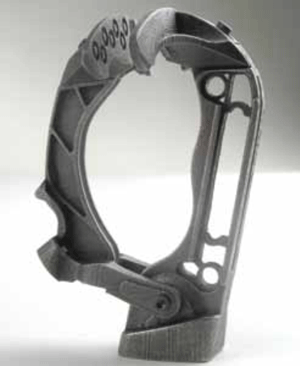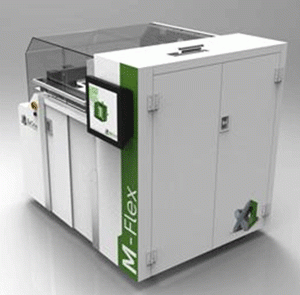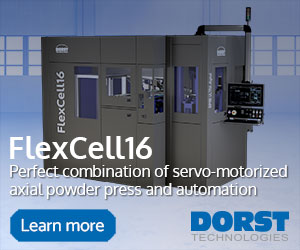New 3D printing system for complex metal shapes from powders
October 17, 2012
The Ex One Company (ExOne), based in Irwin, Penna., USA, recently introduced its newest state-of-the-art 3D printer in the Additive Manufacturing area of the 2012 International Machine Technology Show in Chicago, September 10-15.
The mid-sized M-FLEX 3D Printing System is said to dramatically increase the capabilities of a 3D metal printer, offering more than seven times the volume output of machines currently in use. The 3D metal printer is housed in a build chamber of 400mm x 250mm x 250mm that can achieve build speeds of 30 seconds per layer, compared to previous build speeds of approximately one and a half minutes per layer.
“We’ve made tremendous strides in 3D printing in the last decade and what our machines can do today is simply remarkable. We are printing engine castings for helicopters and replacing broken pumps in oil fields in days not months,” stated Dave Burns, President of ExOne.
“The M-FLEX continues our leadership in developing the 3D printing technology that has made additive manufacturing the most compelling advanced technology used in industry today,” Burns added.
The machine is said to be well suited for either prototypes or short runs of multiple and/or custom parts. The complete machine system includes a printer, recycling equipment, printing materials, a furnace and a comprehensive multimedia training program.
Manufacturing steps in 3D printing

Prosthetic hand components produced using 3D metal
printing technology in stainless steel/bronze
(Courtesy: ExOne Corp.)
After printing in the 3D build box the completed piece is removed from the machine and placed into an oven for curing of the binder to produce green strength for handling. Depending on the mass of the component, the curing operation takes 6-12 hours, and whilst the part is fragile, it can be handled. The part is then placed in a graphite crucible, surrounded by support media, and placed in a vacuum furnace for a 24-36 hr cycle of sintering, infiltrating and annealing. Sintering is performed at about 1100°C to burn off the binder and metallurgically bond the metal particles. After sintering the component is approximately 60% dense.
Infiltration is then performed to increase part density to approximately 95% by filling in all remaining voids between the metal particles. Typically, bronze is wicked into the component through a stilt which is printed into the component and removed after processing. The final step is to gradually cool the furnace to anneal the part. Annealing lowers the tensile and yield strength, making the part less brittle for post machining such as milling, drilling and tapping operations. The component can also be welded and soldered.
After processing, the finish of the component is about a 600 μin Ra (15 μm Ra) with small printing lines remaining visible. Bead blasting improves the finish to approximately 300 μin Ra (7.5 μm Ra). Barrel finishing can improve external surfaces to a 50 μin Ra (1.25 μm Ra). Hand polishing, plating, and anti-corrosion treatments are also available.
ExOne currently offers several metals and metal alloys, including: 316 Stainless Steel/Bronze 420 Stainless Steel/Bronze (Annealed & Non-Annealed), and Bronze. Other metal and ceramic powders are said to be under development.
News | Articles | Market reviews | Search directory | Subscribe to e-newsletter
















